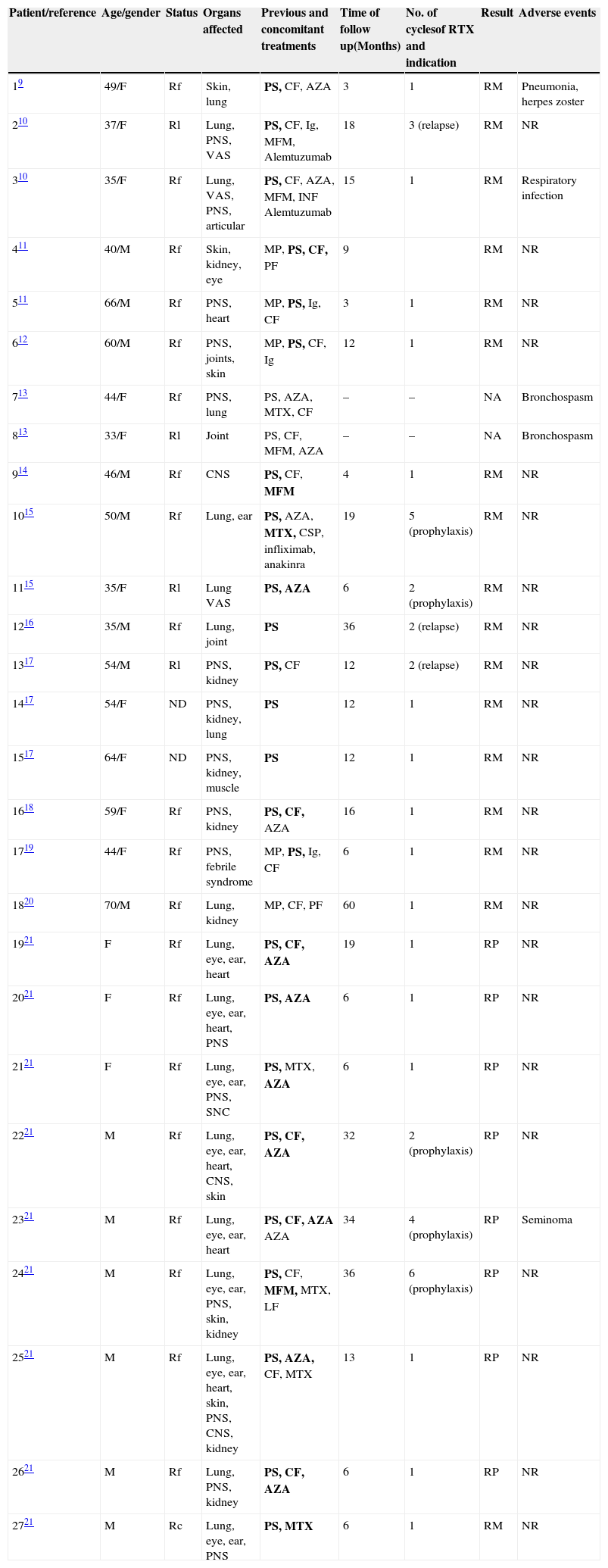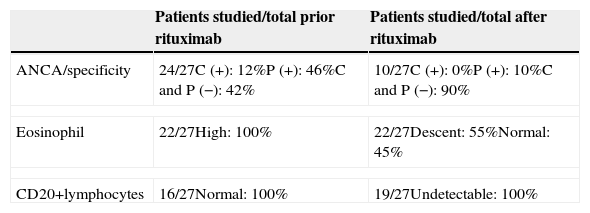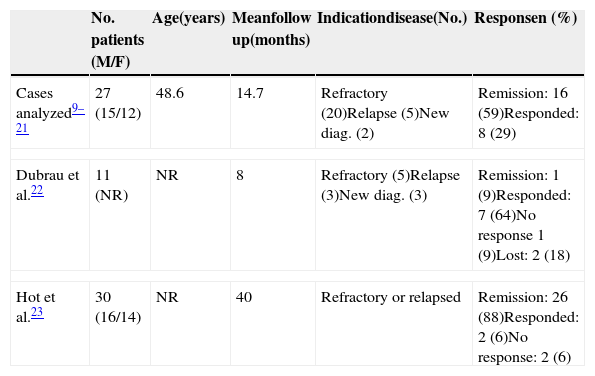The general consensus is that for patients with EGPA with poor prognosis, intensive therapy with both GC and CF is indicated. The maintenance of remission is made with GC and AZA. A considerable number of patients with EGPA are refractory to first line therapy, experience dose-limiting side effects or relapse. In clinical trials, RTX was effective for the treatment of ANCA-associated vasculitis. However, patients with a diagnosis of EGPA were not included.
ObjectiveTo review and analyze the published literature regarding the use of RTX in the treatment of EGPA.
MethodsThe literature search was performed in MEDLINE and LILACS from 1965 and 1986 respectively until February 2014.
Results27 patients were included. RTX treatment was due to refractory disease (n=20), relapse (n=5) and with new diagnosis (n=2). The affected organs were the lungs, peripheral nervous system, kidney and the eyes. Sixteen patients had clinical remission and 8 patients had clinical response.
ConclusionsRTX was effective and well tolerated for the treatment of EGPA.
Algunos pacientes con granulomatosis eosinofílica con poliangitis (EGPA) y factores de mal pronóstico son refractarios o presentan efectos adversos al tratamiento de inducción (glucocorticoides [GC] y ciclofosfamida [CF]), o recaen durante el mantenimiento (GC y azatioprina), haciendo necesaria la búsqueda de alternativas terapéuticas. En ensayos clínicos, el RTX demostró ser eficaz para el tratamiento de las vasculitis asociadas al ANCA; sin embargo, los pacientes con EGPA no fueron incluidos.
ObjetivoRevisar y analizar la bibliografía sobre la uso de RTX para el tratamiento de la EGPA.
MétodosLa búsqueda se realizó en MEDLINE y LILACS (1965 y 1986, respectivamente, hasta febrero del 2014).
ResultadosSe incluyó a 27 pacientes. La indicación de RTX fue por enfermedad refractaria (n=20), recaída (n=5) y nuevo diagnóstico (n=2). Los órganos afectados fueron los pulmones, el sistema nervioso periférico, el riñón y los ojos. Se observó remisión en 16 y respuesta en 8 pacientes.
ConclusionesEl RTX fue eficaz y bien tolerado para el tratamiento de la EGPA.
EGPA is a necrotizing vasculitis that primarily affects small and medium caliber blood vessels, and is defined as a granulomatous inflammatory and necrotizing disease rich in eosinophils that often affects the airway and is characterized by the presence of asthma and eosinophilia. Along with granulomatosis with polyangiitis (Wegener's granulomatosis [GPA]) and microscopic polyangiitis (MPA), they are part of the antineutrophil cytoplasm antibodies (ANCA) associated vasculitis (AAV).1
The general consensus is to treat severe forms of EGPA, defined as those with a score on the 5 factor score (FFS) equal to or greater than 1, with glucocorticoids (GC) and cyclophosphamide (CYP) to achieve clinical remission. Maintaining remission is achieved using GC and AZA. Mild forms (FFA of 0) are treated with GC alone. However, the high rate of adverse events, lack of response to induction treatment or frequent relapses with first line treatments require the study of therapeutic alternatives.2–4
Rituximab (RTX) is a chimeric monoclonal antibody that specifically binds the CD20 antigen, a non-glycosilated transmembrane phosphoprotein expressed on pre-B and B lymphocytes. The reasonable use of this drug in EGPA is mainly based on its good results in case reports and small series of patients who have been refractory to first line treatment and, in addition is supported by its proven efficacy in clinical trials for AAV patients (GPA and MPA).5–8 As patients with EGPA were not included in these trials, RTX approval was not extended to EGPA.
The purpose of this study is to review and analyze the studies published in the literature on the use of RTX in the treatment of EGPA.
Materials and MethodsLiterature search strategy: we consulted the databases of the Medical Literature Analysis and Retrieval System on Line (MEDLINE)/National Library of Medicine (NLM)-Library of Medicine of the United States and the Latin American and Caribbean Literature in Health Sciences (LILACS) library, since 1965 and 1986 respectively, until February 2014. Search terms in English and Spanish were Churg-Strauss (síndrome de Churg-Strauss) syndrome, eosinophilic granulomatosis with polyangiitis (granulomatosis eosinofílica conpoliangitis), allergic granulomatous angiitis (angeí-tis granulomatosa alérgica), RXT and monoclonal anti-CD20 (anti-CD20 monoclonal antibody).
The following data were analyzed: age, sex, affected organs/systems when RTX was indicated, clinical disease state (defined as relapse, treatment resistant or new diagnosis), ANCA determination, eosinophil and B lymphocyte counts in peripheral blood, number of immunosuppressive used before and after treatment with RTX, clinical patient progression and adverse events.
We excluded all those publications that did not have detailed data from the final analysis.
Statistical analysis: Qualitative variables were presented as percentages, and quantitative variables as means±standard deviations or median with minimal and maximum values.
ResultsTable 1 shows the general characteristics of 27 patients with a diagnosis of EGPA included for analysis. Fifteen (55.5%) were male and 12 (44.5%) were female. Median follow-up was 15 months (3–60 months). The indication for RTX treatment was refractory disease in 20 (74.1%), relapse in 5 (18.5%) and a new diagnosis in 2 (7.4%) patients.
General Characteristics of the 27 EGPA Patients Treated With RTX Until February 2014.
| Patient/reference | Age/gender | Status | Organs affected | Previous and concomitant treatments | Time of follow up(Months) | No. of cyclesof RTX and indication | Result | Adverse events |
|---|---|---|---|---|---|---|---|---|
| 19 | 49/F | Rf | Skin, lung | PS, CF, AZA | 3 | 1 | RM | Pneumonia, herpes zoster |
| 210 | 37/F | Rl | Lung, PNS, VAS | PS, CF, Ig, MFM, Alemtuzumab | 18 | 3 (relapse) | RM | NR |
| 310 | 35/F | Rf | Lung, VAS, PNS, articular | PS, CF, AZA, MFM, INF Alemtuzumab | 15 | 1 | RM | Respiratory infection |
| 411 | 40/M | Rf | Skin, kidney, eye | MP, PS, CF, PF | 9 | RM | NR | |
| 511 | 66/M | Rf | PNS, heart | MP, PS, Ig, CF | 3 | 1 | RM | NR |
| 612 | 60/M | Rf | PNS, joints, skin | MP, PS, CF, Ig | 12 | 1 | RM | NR |
| 713 | 44/F | Rf | PNS, lung | PS, AZA, MTX, CF | – | – | NA | Bronchospasm |
| 813 | 33/F | Rl | Joint | PS, CF, MFM, AZA | – | – | NA | Bronchospasm |
| 914 | 46/M | Rf | CNS | PS, CF, MFM | 4 | 1 | RM | NR |
| 1015 | 50/M | Rf | Lung, ear | PS, AZA, MTX, CSP, infliximab, anakinra | 19 | 5 (prophylaxis) | RM | NR |
| 1115 | 35/F | Rl | Lung VAS | PS, AZA | 6 | 2 (prophylaxis) | RM | NR |
| 1216 | 35/M | Rf | Lung, joint | PS | 36 | 2 (relapse) | RM | NR |
| 1317 | 54/M | Rl | PNS, kidney | PS, CF | 12 | 2 (relapse) | RM | NR |
| 1417 | 54/F | ND | PNS, kidney, lung | PS | 12 | 1 | RM | NR |
| 1517 | 64/F | ND | PNS, kidney, muscle | PS | 12 | 1 | RM | NR |
| 1618 | 59/F | Rf | PNS, kidney | PS, CF, AZA | 16 | 1 | RM | NR |
| 1719 | 44/F | Rf | PNS, febrile syndrome | MP, PS, Ig, CF | 6 | 1 | RM | NR |
| 1820 | 70/M | Rf | Lung, kidney | MP, CF, PF | 60 | 1 | RM | NR |
| 1921 | F | Rf | Lung, eye, ear, heart | PS, CF, AZA | 19 | 1 | RP | NR |
| 2021 | F | Rf | Lung, eye, ear, heart, PNS | PS, AZA | 6 | 1 | RP | NR |
| 2121 | F | Rf | Lung, eye, ear, PNS, SNC | PS, MTX, AZA | 6 | 1 | RP | NR |
| 2221 | M | Rf | Lung, eye, ear, heart, CNS, skin | PS, CF, AZA | 32 | 2 (prophylaxis) | RP | NR |
| 2321 | M | Rf | Lung, eye, ear, heart | PS, CF, AZA AZA | 34 | 4 (prophylaxis) | RP | Seminoma |
| 2421 | M | Rf | Lung, eye, ear, PNS, skin, kidney | PS, CF, MFM, MTX, LF | 36 | 6 (prophylaxis) | RP | NR |
| 2521 | M | Rf | Lung, eye, ear, heart, skin, PNS, CNS, kidney | PS, AZA, CF, MTX | 13 | 1 | RP | NR |
| 2621 | M | Rf | Lung, PNS, kidney | PS, CF, AZA | 6 | 1 | RP | NR |
| 2721 | M | Rc | Lung, eye, ear, PNS | PS, MTX | 6 | 1 | RM | NR |
AZA: azathioprine; CF: cyclophosphamide; CSP: cyclosporin; ND: new diagnosis; F: female; Ig: immunoglobulin; M: male; MFM: mycohenolate mofetil; MP: methylprednisolone; MTX: methotrexate, NA: not applicable; NR: not reported; PF: plasmapheresis; PS: prednisone; Rl: relapse; Rf: refractory; RP: response; RM: remission; CNS: central nervous system; PNS: peripheral nervous system; RTX: rituximab; UA: upper airway.
The affected organs that prompted the use of RTX were the lungs (n=18, 66.6%) (asthma, pulmonary infiltrates or alveolar hemorrhage), the peripheral nervous system (n=16, 59.3%) (mono- or polyneuropathy), kidneys (n=9, 33.3%), eyes (n=9, 33.3%) and heart (n=6, 22.2%) (Table 1).
ANCA were reported in 14 patients (51.8%), 11 (78.6%) with a perinuclear pattern (P-ANCA) and 3 (21.4%) with a cytoplasmic pattern (C-ANCA). In 10 (33.1%) patients, ANCA were negative and in 3 (11.1%) the ANCA status was not reported. The number of eosinophils, before the start of treatment with RTX, was elevated in all patients (Table 2).
Details of the Presence of ANCA, Eosinophils and Lymphocytes CD20+ Before and After Treatment With RTX.
| Patients studied/total prior rituximab | Patients studied/total after rituximab | |
|---|---|---|
| ANCA/specificity | 24/27C (+): 12%P (+): 46%C and P (−): 42% | 10/27C (+): 0%P (+): 10%C and P (−): 90% |
| Eosinophil | 22/27High: 100% | 22/27Descent: 55%Normal: 45% |
| CD20+lymphocytes | 16/27Normal: 100% | 19/27Undetectable: 100% |
The median of immunosuppressive drugs (including GC) used before the start of treatment with RTX was 3 (range 1–6).
The treatment strategies with RTX employed were: 375mg/m2 of total body surface every 7 days, a total of 4 infusions (n=8; 2) 1000mg every 15 days, a total of 2 infusions (n=13) and variants of these (n=4).
In 2 patients the RTX infusion was suspended due to adverse reactions, making it unable to finish the therapy.
Excluding the use of GC, 14 patients used another immunosuppressive drug concomitantly with RTX (CYP, AZA, methotrexate and mycophenolate mofetil).
Response to TreatmentClinical disease remission was seen in 16 (59.2%) patients and response in 8 (29.6%) patients (Tables 1 and 3).
Details of Response to Treatment With RTX in EGPA Cases Analyzed and 2 Recent Series Reported in Abstracts.
| No. patients (M/F) | Age(years) | Meanfollow up(months) | Indicationdisease(No.) | Responsen (%) | |
|---|---|---|---|---|---|
| Cases analyzed9–21 | 27 (15/12) | 48.6 | 14.7 | Refractory (20)Relapse (5)New diag. (2) | Remission: 16 (59)Responded: 8 (29) |
| Dubrau et al.22 | 11 (NR) | NR | 8 | Refractory (5)Relapse (3)New diag. (3) | Remission: 1 (9)Responded: 7 (64)No response 1 (9)Lost: 2 (18) |
| Hot et al.23 | 30 (16/14) | NR | 40 | Refractory or relapsed | Remission: 26 (88)Responded: 2 (6)No response: 2 (6) |
NR: not reported.
In 3 (12%) patients a relapse was observed and in 2 of them this coincided with the reappearance of CD20+B lymphocytes in peripheral blood. All 3 patients were retreated with RTX, with a clinical response.
Table 2 shows the evolution of ANCA, eosinophil counts and the determination of CD20+B lymphocytes in patients before and after the administration of RTX.
Adverse events reported are detailed in Table 1. In 2 patients the first infusion of RTX had to be suspended due to serious bronchospasm; the remaining adverse events were respiratory infections and an episode of herpes zoster. One patient was diagnosed with a seminoma 12 months after receiving RTX. There were no deaths.
DiscussionEGPA belongs to the group of AAV along with GPA and MPA; however, it differs from them in several ways. The current treatment of EGPA is similar to that of the remaining AAV, but differs in that RTX has no defined indication as in GPA and MPA, as the randomized clinical trials such as the RAVE and RITUXVAS5,6 did not include patients with EGPA. So far, there are only anecdotal reports of EGPA patients treated with RTX, which makes it difficult to assess the effectiveness of this drug in this disease.
An analysis of the literature shows that most EGPA patients treated with RTX were refractory to first line treatment or relapsed during maintenance immunosuppressive therapy. Only 5 patients received RTX as first line induction treatment (Table 3).
In all patients there was a rapid response observed after treatment with RTX; 2 patients did not complete the infusion of the drug due to a severe adverse reaction.12 Clinical disease remission was seen in most patients. Three patients had one or more relapses, but responded to a new cycle of RTX. Table 3 shows the response to treatment with RTX of cases analyzed along with 2 sets of cases recently reported as abstracts.22,23
A major problem in patients with EGPA is the persistence of symptoms of asthma, despite treatment and the morbidity dependent on long-term GC treatment. While the studies did not analyze the therapeutic response of asthma to RTX, a recent communication presented at the 16th International Vasculitis & ANCA Workshop (Paris, France) by Hot et al. found that 39% of patients treated with RTX for EGPA continued with GC requirements due to persistent asthma.23
Decreased values of peripheral blood eosinophil were reduced or normal after treatment with RTX regardless of the dosage regimen used, in most patients. This finding puts the close relationship that the different cells of the immune system, and especially the strong Th2 lymphocyte interaction through the secretion of cytokines (IL-4, IL-5 and IL-13), with the B cell and the subsequent production and secretion of eotaxin-1, IgG4, IgE and ANCA in perspective.2,24 IgE is elevated in the serum of patients with EGPA. This immunoglobulin, which is produced by plasma cells, is bound to receptors (Fc¿R1) on the surface of eosinophils, which, by binding to antigen, induces their involvement in the inflammatory response. Furthermore, eotaxin-1 participates in the recruitment of eosinophils to the site of inflamation.2 These mechanisms could explain in part the decline of eosinophils after treatment with RTX.
Circulating CD20+lymphocytes after RTX use were undetectable and thus persisted for variable time. The period until the repopulation of CD20+B cells was not uniform and in some patients was not correlated with the clinical evolution of the disease. In the RAVE6 study, a high percentage of patients had undetectable CD20+B cell counts after the infusion of RTX (as occurred in the group using CYP) and the time to repopulation thereof was variable. Of greater importance was the finding regarding the repopulation of CD20+B lymphocytes as an isolated variable that did not predict the relapse risk in the individual patient. However, patients who after the use of RTX persisted with undetectable CD20+B lymphocyte levels and negative ANCA were unlikely to relapse.
ANCA are not the only pathogenic mechanism involved in the genesis of this vasculitis; EGPA patients have a strong IgG4 response regardless of the status of ANCA; evidence of a dialog between the B lymphocytes and eosinophils, and the ability of the B cell to secrete eotaxin-1, which is involved in the recruitment of eosinophils at sites of inflammation24–26 could be another pathogenic mechanism involved in the response mediated by RTX; therefore the fact that a patient is ANCA negative does not predict a failure to respond to treatment with RTX.
RTX was well tolerated; only 2 patients experienced adverse reactions during infusion. Adverse events were minor, usually respiratory infections in outpatient care. No deaths directly attributed to RTX were reported. This is consistent with the adverse effects reported in large series and extensive clinical studies demonstrating the safety of RTX in the treatment of AAV.5–8
The most commonly used treatment strategies were: RTX 1000mg every 15 days (total 2 infusions) and 375mg/m2 of RTX per week (total of 4 infusions). Although both strategies were not formally compared, they appear to be equally effective for the induction of remission in the AAV; the expert recommendation on the use of RTX in AAV is to use both strategies interchangeably.27
This study has limitations: the number of patients is small, follow-up time is limited, definitions of activity and damage were not uniform – only in some studies was the Birmingham Vasculitis Activity Score used, and in different versions, immunosuppressive drugs and use of RTX differed between patients. In addition, we did not find publications regarding EGPA patients who did not respond to RTX.
However, there is a widespread tendency to reconsider the standards of treatment for AAV, including EGPA, both in the induction as well as in the maintenance.28,29
Finally, RTX appears to be effective and safe for the treatment of refractory EGPA, relapses or newly diagnosed, independent ANCA status. Randomized clinical trials are necessary to confirm this observation.
Ethical ResponsibilitiesProtection of people and animalsThe authors declare that this research did not perform experiments on humans or animals.
Data privacyThe authors state that no patient data appear in this article.
Right to privacy and informed consentThe authors state that no patient data appear in this article.
Conflict of InterestNone.
Please cite this article as: Muñoz SA, Gandino IJ, Orden AO, Allievi A. Rituximab en el tratamiento de la granulomatosis eosinofílica con poliangitis. Reumatol Clin. 2015;11:165–169.









